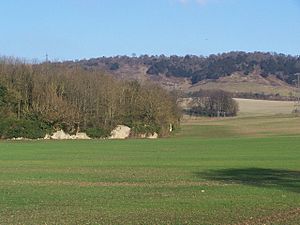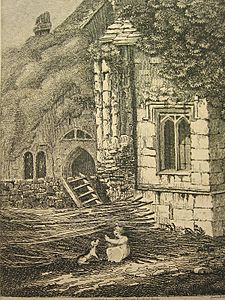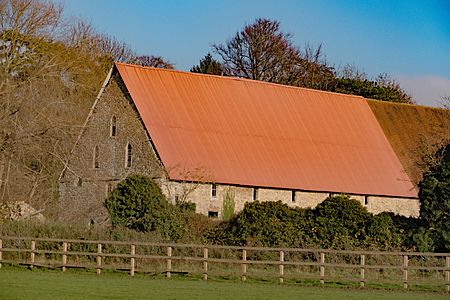Boxley Abbey facts for kids

Boxley Abbey was a large monastery in Boxley, Kent, England. It was founded around 1146 by William of Ypres. Monks from Clairvaux Abbey in France came to live there. Today, some of its old buildings are still standing, about four miles north-east of Maidstone.
Contents
Boxley Abbey's Story
Key Events in Abbey Life
In 1171, the leader of the abbey, called the abbot, helped bury Thomas Becket. Thomas Becket was an archbishop who had been murdered. Later, in 1193, the abbots of Boxley and Robertsbridge traveled to Europe. They were searching for King Richard I, and they found him in Bavaria.
The Rood of Grace Mystery

Boxley Abbey was well-known for a special item called the Rood of Grace. This was a wooden cross with a figure on it. People believed the figure could move and even speak on its own.
However, in 1538, during the time when King Henry VIII was closing down monasteries, a man named Geoffrey Chamber inspected the Rood. He found out it was not a miracle. Instead, it had hidden levers and wires that made the figure move.
The Rood was then taken to Maidstone market. It was shown to everyone to prove it was a trick. After that, it was sent to London. There, it was broken into pieces and burned in front of St Paul's Cathedral.
Some historians believe this moving figure was not meant to trick people into thinking it was a miracle. They suggest it might have been a kind of theatrical show. This "puppetry" could have been presented to an audience who knew it was a performance. Also, some religious statues from the 1100s did have moving parts for devotion, not for fraud.
Other Abbey Tricks
The monks at Boxley Abbey had other clever ways to get donations. There was a statue of the infant Saint Rumbold. A legend said only truly good people could lift it. But the monks had a secret bolt under the statue. They would unlock it for people who gave a lot of money.
They also had what they claimed was the finger of the apostle Andrew. This finger was covered in silver. But when fewer visitors came, the monks pawned it to a local merchant for eleven pounds.
The Abbey's End and What Remains
Boxley Abbey was officially closed down on January 29, 1537. This was part of the Dissolution of the Monasteries, when King Henry VIII closed many religious houses in England.
In 1540, the land and buildings were given to Sir Thomas Wyatt. After the abbey closed, some parts were turned into a house. Most of the other buildings were torn down.
Today, some parts of the old church still stand. These are found within the current Boxley Abbey House, which was mostly built in the 1800s. The Boxley Abbey Barn is a large stone building from the 1200s. It used to be the abbey's guest house for visitors. This barn is still standing and is a very important historical building. The area where the abbey once stood is a protected historical site. The site is on private land. The local church, St Mary and All Saints, was also connected to the abbey.




